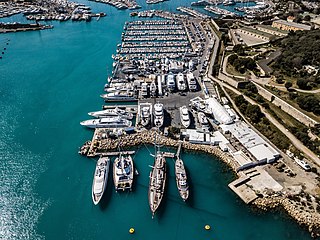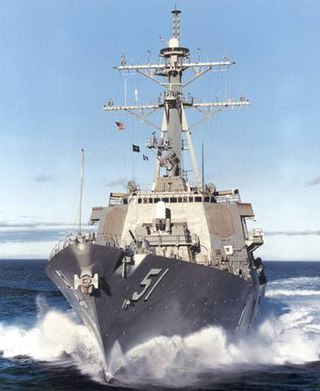
The Royal Australian Navy (RAN) is the naval force of the Australian Defence Force (ADF). The professional head of the RAN is Chief of Navy (CN) Vice Admiral Mark Hammond AM, RAN. CN is also jointly responsible to the Minister of Defence (MINDEF) and the Chief of Defence Force (CDF). The Department of Defence as part of the Australian Public Service administers the ADF.

The Virginia class, or the SSN-774 class, is the latest class of nuclear-powered cruise missile fast-attack submarines in service with the United States Navy. Designed by General Dynamics Electric Boat (EB) and Huntington Ingalls Industries, the Virginia class incorporates the latest in stealth, intelligence gathering, and weapons systems.

A shipyard, also called a dockyard or boatyard, is a place where ships are built and repaired. These can be yachts, military vessels, cruise liners or other cargo or passenger ships. Compared to shipyards, which are sometimes more involved with original construction, dockyards are sometimes more linked with maintenance and basing activities. The terms are routinely used interchangeably, in part because the evolution of dockyards and shipyards has often caused them to change or merge roles.

HMAS Collins is the lead vessel of the six-submarine Collins class operated by the Royal Australian Navy (RAN).

The Anzac class is a ship class of ten frigates; eight operated by the Royal Australian Navy (RAN) and two operated by the Royal New Zealand Navy (RNZN). During the 1980s, the RAN began plans to replace the River-class destroyer escorts with a mid-capability patrol frigate and settled on the idea of modifying a proven German design for Australian conditions. Around the same time, the RNZN was seeking to replace their Leander-class frigates while maintaining blue-water capabilities. A souring of relations between New Zealand and the United States of America in relation to New Zealand's nuclear-free zone and the ANZUS security treaty prompted New Zealand to seek improved ties with other nations, particularly Australia. As both nations were seeking warships of similar capabilities, the decision was made in 1987 to collaborate on their acquisition. The project name is taken from the Australian and New Zealand Army Corps of the First World War.
The Barracuda class is a class of nuclear attack submarines, designed by the French shipbuilder Naval Group for the French Navy. It is intended to replace the Rubis-class submarines. Construction began in 2007 and the first unit was commissioned on 6 November 2020. The lead boat of the class, Suffren, entered service on 3 June 2022.

The Hobart class is a ship class of three air warfare destroyers (AWDs) built for the Royal Australian Navy (RAN). Planning for ships to replace the Adelaide-class frigates and restore the capability last exhibited by the Perth-class destroyers began by 2000, initially under acquisition project SEA 1400, which was re-designated SEA 4000. Although the designation "Air Warfare Destroyer" is used to describe ships dedicated to the defence of a naval force from aircraft and missile attack, the planned Australian destroyers are expected to also operate in anti-surface, anti-submarine, and naval gunfire support roles.
The Royal Australian Navy, although a significant force in the Asia-Pacific region, is nonetheless classed as a medium-sized navy. Its fleet is based around two main types of surface combatant, with limited global deployment and air power capability. However, in 2009, a white paper, Defending Australia in the Asia Pacific Century: Force 2030, was produced by the Australian government which set out a programme of defence spending that will see significant improvements to the RAN's fleet and capabilities.

A hull number is a serial identification number given to a boat or ship. For the military, a lower number implies an older vessel. For civilian use, the HIN is used to trace the boat's history. The precise usage varies by country and type.

ASC Pty Ltd, formerly the Australian Submarine Corporation, is an Australian government business enterprise involved with Australian naval shipbuilding, headquartered in Osborne, South Australia. It is notable for the construction and maintenance of the Collins-class submarine fleet operated by the Royal Australian Navy (RAN) and the construction of three Hobart-class destroyers for the RAN with the first delivered in mid-2017.

Mazagon Dock Shipbuilders Limited (MDL), formerly called Mazagon Dock Limited, is a shipyard situated in Mazagaon, Mumbai. It manufactures warships and submarines for the Indian Navy and offshore platforms and associated support vessels for offshore oil drilling. It also builds tankers, cargo bulk carriers, passenger ships and ferries.

Garden Reach Shipbuilders & Engineers Ltd, abbreviated as GRSE, is one of India's leading shipyards, located in Kolkata. It builds and repairs commercial and naval vessels. GRSE also builds export ships.

The Arafura class is a class of offshore patrol vessels being built for the Royal Australian Navy (RAN). Initially proposed in the 2009 Defence White Paper and marked as procurement project SEA 1180, it was originally planned that 20 Offshore Combatant Vessels (OCV) would replace 26 vessels across four separate ship classes: the Armidale-class patrol boats, the Huon-class minehunters, the Leeuwin-class survey vessels, and the Paluma-class survey motor launches. Although having a common design, the ships would use a modular mission payload system to fulfill specific roles; primarily border patrol, mine warfare, and hydrographic survey. The 2013 Defence White Paper committed to the OCV project as a long-term goal, but opted in the short term for an accelerated procurement of an existing design to replace the Armidales, and life-extension refits for the other types. This resulted in the Offshore Patrol Vessel (OPV) project and the number of vessels reduced to 12. However, this was further increased to 14 when 2 further Mine Counter Measures variants were proposed under SEA 1905.

The Hunter-class frigate is a future class of heavy frigates for the Royal Australian Navy (RAN) to replace the Anzac class. Construction was expected to begin in 2023, with the first of nine vessels to enter service in 2031.
ASC Shipbuilding, formerly the shipbuilding division of ASC Pty Ltd, is a subsidiary of BAE Systems Australia and will remain a subsidiary for the duration of the contract to build the Hunter class frigates. It was structurally separated from ASC Pty Ltd in December 2018 and became a subsidiary of BAE Systems Australia. In 2021 it was renamed as BAE Systems Maritime Australia.

NUSHIP Arafura, named to represent Australia's interests in the Arafura Sea, is the lead ship of the Arafura-class offshore patrol vessels currently under construction for the Royal Australian Navy. The ship is based on the Lürssen OPV80 design, and is being constructed by ASC Pty Ltd at the Osborne Naval Shipyard in Osborne, South Australia. It was planned that the ship would enter service in 2022. However, as of March 2023, it is yet to be commissioned. The ship was launched at the Osborne Naval Shipyard on 16 December 2021.
Civmec Limited is a dual-listed Singaporean-Australian public company involved in the construction, engineering and shipbuilding industries. Headquartered in Perth, Western Australia, it specialises in fabrication and construction for the oil and gas and mining industries and has been involved in a number of significant Australian mining and civil engineering projects and has been selected to build a number of vessels and facilities for the Royal Australian Navy.

The SSN-AUKUS, also known as the SSN-A, is a planned class of nuclear-powered fleet submarine (SSN) intended to enter service with the United Kingdom's Royal Navy in the late 2030s and Royal Australian Navy in the 2040s. The class will replace the UK's Astute class and Australia's Collins class submarines.
The Australian Submarine Agency (ASA), formerly the Nuclear-Powered Submarine Task Force (NPSTF) is the federal statutory agency of the Australian Government responsible for the management and oversight of Australia's nuclear-powered submarine program. The ASA was established as a non-corporate Commonwealth entity under the Department of Defence consisting of defence personnel and Australian public servants. Personnel will be based across Australia as well as in the United Kingdom and the United States, numbering 350 increasing to 680 within the following year.


















